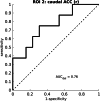Cortical Thickness in the Right Anterior Cingulate Cortex Relates to Clinical Response to Left Prefrontal Accelerated Intermittent Theta Burst Stimulation: An Exploratory Study
- PMID: 33788975
- PMCID: PMC8360012
- DOI: 10.1111/ner.13380
Cortical Thickness in the Right Anterior Cingulate Cortex Relates to Clinical Response to Left Prefrontal Accelerated Intermittent Theta Burst Stimulation: An Exploratory Study
Abstract
Objectives: Accelerated intermittent theta burst stimulation (aiTBS) is a promising treatment option for depressed patients. However, there is a large interindividual variability in clinical effectiveness and individual biomarkers to guide treatment outcome are needed.
Materials and methods: Here, the relation between cortical thickness and clinical response (17-item Hamilton Depression Rating Scale) was studied using anatomical MRI data of 50 depressed patients who were included in a randomized, sham-controlled, double-blinded, cross-over aiTBS design (NCT01832805).
Results: Baseline cortical thickness in the right caudal part of the anterior cingulate cortex (cACC) was significantly correlated with direct clinical responses in the subgroup who received active aiTBS during the first stimulation week. No correlations were found between baseline cortical thickness and delayed clinical effectiveness. In this particular region, longitudinal changes in cortical thickness were significantly correlated with clinical effectiveness. Furthermore, direct changes in cortical thickness in the right cACC showed predictive potential of delayed clinical responses.
Conclusion: Cortical thickness within the right cACC might be an important biomarker to predict clinical responses to aiTBS. Additional studies are warranted to substantiate the specific biomarker potential of these parts of the ACC.
Keywords: Brain stimulation/TMS/DBS/VNS; biological markers; depression; neuroimaging; neurostimulation.
© 2021 The Authors. Neuromodulation: Technology at the Neural Interface published by Wiley Periodicals LLC on behalf of International Neuromodulation Society.
Figures









Similar articles
-
Subgenual Anterior Cingulate-Medial Orbitofrontal Functional Connectivity in Medication-Resistant Major Depression: A Neurobiological Marker for Accelerated Intermittent Theta Burst Stimulation Treatment?Biol Psychiatry Cogn Neurosci Neuroimaging. 2017 Oct;2(7):556-565. doi: 10.1016/j.bpsc.2017.01.001. Epub 2017 Jan 20. Biol Psychiatry Cogn Neurosci Neuroimaging. 2017. PMID: 29560909 Clinical Trial.
-
Indirect frontocingulate structural connectivity predicts clinical response to accelerated rTMS in major depressive disorder.J Psychiatry Neurosci. 2020 Jul 1;45(4):243-252. doi: 10.1503/jpn.190088. J Psychiatry Neurosci. 2020. PMID: 31990490 Free PMC article. Clinical Trial.
-
Accelerated iTBS treatment applied to the left DLPFC in depressed patients results in a rapid volume increase in the left hippocampal dentate gyrus, not driven by brain perfusion.Brain Stimul. 2020 Sep-Oct;13(5):1211-1217. doi: 10.1016/j.brs.2020.05.015. Epub 2020 Jun 5. Brain Stimul. 2020. PMID: 32512184 Clinical Trial.
-
Placebo aiTBS attenuates suicidal ideation and frontopolar cortical perfusion in major depression.Transl Psychiatry. 2019 Jan 29;9(1):38. doi: 10.1038/s41398-019-0377-x. Transl Psychiatry. 2019. PMID: 30696807 Free PMC article. Clinical Trial.
-
Cingulate role in Tourette syndrome.Handb Clin Neurol. 2019;166:165-221. doi: 10.1016/B978-0-444-64196-0.00011-X. Handb Clin Neurol. 2019. PMID: 31731911 Review.
Cited by
-
Relationship between Non-Invasive Brain Stimulation and Autonomic Nervous System.Biomedicines. 2024 Apr 28;12(5):972. doi: 10.3390/biomedicines12050972. Biomedicines. 2024. PMID: 38790934 Free PMC article. Review.
-
Cortical glutamate, Glx, and total N-acetylaspartate: potential biomarkers of repetitive transcranial magnetic stimulation treatment response and outcomes in major depression.Transl Psychiatry. 2024 Jan 6;14(1):5. doi: 10.1038/s41398-023-02715-9. Transl Psychiatry. 2024. PMID: 38184652 Free PMC article.
-
A Preclinical Study of Standard Versus Accelerated Transcranial Magnetic Stimulation for Depression in Adolescents.J Child Adolesc Psychopharmacol. 2022 Apr;32(3):187-193. doi: 10.1089/cap.2021.0100. Epub 2021 Dec 31. J Child Adolesc Psychopharmacol. 2022. PMID: 34978846 Free PMC article.
-
Cortical hypometabolism as a predictor of intermittent theta burst stimulation response in treatment-resistant depression patients: An open-label study.Indian J Psychiatry. 2024 Dec;66(12):1154-1158. doi: 10.4103/indianjpsychiatry.indianjpsychiatry_161_24. Epub 2024 Dec 12. Indian J Psychiatry. 2024. PMID: 39867246 Free PMC article.
-
A transdiagnostic review of safety, efficacy, and parameter space in accelerated transcranial magnetic stimulation.J Psychiatr Res. 2022 Aug;152:384-396. doi: 10.1016/j.jpsychires.2022.06.038. Epub 2022 Jun 28. J Psychiatr Res. 2022. PMID: 35816982 Free PMC article. Review.
References
-
- WHO factsheet: Depression. https://www.who.int/news-room/fact-sheets/detail/depression.
-
- Mcclintock SM, Reti IM, Carpenter LL et al. Consensus recommendations for the clinical application of repetitive Transcranial magnetic stimulation (rTMS) in the treatment of depression on behalf of both the National Network of depression centers rTMS task group and the American psychiatric Associat. J Clin Psychiatry 2018;79:1–32. 10.4088/JCP.16cs10905. - DOI - PMC - PubMed
Publication types
MeSH terms
Associated data
LinkOut - more resources
Full Text Sources
Other Literature Sources
Medical

